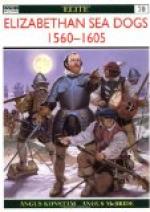Yet, strangely enough, King Henry’s first modern men-of-war grew out of a merchant-ship model, and a foreign one at that. Throughout ancient and medieval times the ‘long ship’ was the man-of-war while the ‘round ship’ was the merchantman. But the long ship was always some sort of galley, which, as we have seen repeatedly, depended on its oars and used sails only occasionally, and then not in action, while the round ship was built to carry cargo and to go under sail. The Italian naval architects, then the most scientific in the world, were trying to evolve two types of vessel: one that could act as light cavalry on the wings of a galley fleet, the other that could carry big cargoes safely through the pirate-haunted seas. In both types sail power and fighting power were essential. Finally a compromise resulted and the galleasse appeared. The galleasse was a hybrid between the galley and the sailing vessel, between the ‘long ship’ that was several times as long as it was broad and the ‘round ship’ that was only two or three times as long as its beam. Then, as the oceanic routes gained on those of the inland seas, and as oceanic sea power gained in the same proportion, the galleon appeared. The galleon had no oars at all, as the hybrid galleasses had, and it gained more in sail power than it lost by dropping oars. It was, in fact, the direct progenitor of the old three-decker which some people still alive can well remember.
At the time the Cabots and Columbus were discovering America the Venetians had evolved the merchant-galleasse for their trade with London: they called it, indeed, the galleazza di Londra. Then, by the time Henry VIII was building his new modern navy, the real galleon had been evolved (out of the Italian new war- and older merchant-galleasses) by England, France, and Scotland; but by England best of all. In original ideas of naval architecture England was generally behind, as she continued to be till well within living memory. Nelson’s captains competed eagerly for the command of French prizes, which were better built and from superior designs. The American frigates of 1812 were incomparably better than the corresponding classes in the British service were; and so on in many other instances. But, in spite of being rather slow, conservative, and rule-of-thumb, the English were already beginning to develop a national sea-sense far beyond that of any other people. They could not, indeed, do otherwise and live. Henry’s policy, England’s position, the dawn of oceanic strategy, and the discovery of America, all combined to make her navy by far the most important single factor in England’s problems with the world at large. As with the British Empire now, so with England then: the choice lay between her being either first or nowhere.




